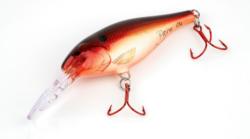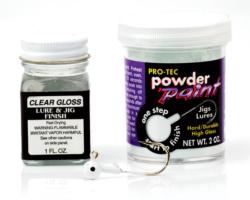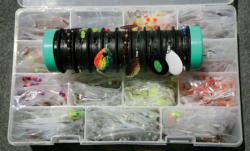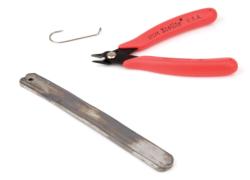Customizing for a competitive advantage
Taking a great bait and making it better has become a new art form

In all sports, competitors always look for small details that will give them an edge. For a runner, it might be adding a revolutionary type of spike to his sprinting shoes or a certain cutting-edge regimen of hydration before a big race. For NASCAR drivers, there are tweaks and customizations mechanics can make to cars in an attempt to give them a performance advantage.
For anglers, the tweaks to tackle and equipment are infinite because of the limitless options of colors, shapes, sizes and actions of baits on the market. The competition isn’t angler versus angler in this game. It’s angler versus fish – and anything that gives you a leg up in that competition is good.
Why customize?
Baits being produced by top manufacturers are of increasing quality and options every year. The baits of today are light years ahead of the baits of yesteryear in terms of quality components, finishes and colors. Every manufacturer attempts to show fish something a little different from earlier versions of like baits. Some of the new finishes on the market are masterpieces of art and design and subsequently have dramatically increased the price of baits over the years.
There is an old adage that lures were made to attract anglers more than fish. That’s not as true as most would think. The fact that there are so many bodies of water to fish from coast to coast and border to border and so many different colors, sizes and shapes of available forage that somewhere, at some time of year, there is a specific color and pattern that is the hot ticket to catching walleyes.
Chrome with a blue back might be red hot on Green Bay while chartreuse with a purple back might be an even hotter color at the same exact time up the Mississippi River. So, do manufacturers make every color for every single lake and river in the country? Of course not; that’s just not feasible.
Another aspect of customizing color, for example, is that there might be a perfectly shaped bait with a perfect action for a certain time of year. However, another manufacturer might have the perfect color. If only you could have that color on the other bait. Through customization, the perfect combination can be had with one unique lure. Furthermore, confidence can be an anglers’ greatest advantage, and just throwing a lure that looks perfect for the situation may help catch more fish.
 “It’s all about customizing to the situation,” said longtime custom-lure painter and designer John Prior of Ila, Ga. Prior is known in bass tournament circles as being a master crankbait and jerkbait painter.
“It’s all about customizing to the situation,” said longtime custom-lure painter and designer John Prior of Ila, Ga. Prior is known in bass tournament circles as being a master crankbait and jerkbait painter.
He has an extensive list of bass pros that buy custom painted baits from him and he’s done a lot of work painting baits that many walleye anglers like to throw, such as Rapala Shad Raps and Smithwick Rogues.
“About 42 pros have bought baits or had me paint baits for them, and several more have gotten them from these pros without me being involved,” Prior said.
Prior has been working on bait painting and designing for more than 10 years now and paints more than 900 crankbaits per year.
Bait customization isn’t about taking away business from manufacturers, either. Though most serious anglers buy more lures than they need, anglers looking to customize a particular lure often buy them in bulk.
“I’ll get a call from a guy who wants 20 Rapala Shad Raps painted with a specific pattern for a lake where he’s going to fish a tournament,” Prior said. “That’s 20 Rapala Shad Raps that were just sold in the name of custom painting. It’s not about taking business from the big manufacturers; it’s about making their great products even better.”
Do it yourself or have it done?
 For anglers wanting to customize their own baits, there have been volumes of articles, tutorials and tips written about easy customizations like adding rattles, adding tail feathers to treble hooks, dying plastics and trailers, or adding weights to hard baits to make them suspend. But there are a plethora of bait customizations, from painting crankbaits to pouring lead jigheads.
For anglers wanting to customize their own baits, there have been volumes of articles, tutorials and tips written about easy customizations like adding rattles, adding tail feathers to treble hooks, dying plastics and trailers, or adding weights to hard baits to make them suspend. But there are a plethora of bait customizations, from painting crankbaits to pouring lead jigheads.
Because of that, the first place you should start is in research. Several companies exist that cater to those brave souls wanting to customize their baits. One of the best resources for this topic is one of the most popular lure-customizing Web sites, called Tackle Underground (tackleunderground.com). TU, as it’s referred to by its members, was created by Jerry Goodwin as a place to learn the tricks of the trade as well as share work and seek out some of the obsessively talented bait designers and painters in the custom-bait sub-industry. Nearly everything you’ve ever wanted to know about how to customize a bait has been discussed in their forums.
Once you’ve done the research on how to do the customization, the next step is to collect the equipment. For things like making your own skirts, the process is simple and inexpensive. However, when you get more advanced and look to airbrush your own crankbaits or pour your own leadheads, there will be a bit of startup capital required. Several of the top retailers for these components are listed at the end of this article.
Understanding what goes into customizing a lure, as well as what the benefits and pitfalls are, will help anglers better understand what they need from a veteran lure customizer before laying any money down.
Painting hard baits
Manufacturers put a lot of time and thought into the design of baits, and most are perfectly balanced straight out of the package. As they go through wear and tear over the years, their actions may be altered, and a custom paint job can be just the ticket for revitalizing a retired bait. Or, a bait may have the perfect action and just be lacking a key pattern that is a proven winner on a certain lake.
“The key to customizing an existing bait is moderation,” Prior said. “A total custom paint job on a hard bait is not just shooting some paint on it in a killer pattern and then applying a nice, shiny clear coat for protection. It can be a great way to revive a bait or make it more productive, but it can also be a sure-fire way to ruin the action of the bait. A seasoned professional and weekend angler alike will peg you on a bait that you’ve ruined with too much paint.
 “I inspect every bait for dings and damage,” Prior continued. “Then I sand and buff the bait ultra smooth. I do a bit of prep cleaning for superior paint adhesion. The lips are precisely masked before painting. Then I prime the bait and buff it smooth again and blow off excess primer. I apply a base coat and paint the bait to specification with an airbrush with top-of-the-line acrylic lacquer paint. I then put on the most durable clear coat that will last for the life of the bait and sign it with a guarantee that if the paint comes off, I’ll repaint it for free. I’m trying to make the best bait possible every time. There are no cutting corners.”
“I inspect every bait for dings and damage,” Prior continued. “Then I sand and buff the bait ultra smooth. I do a bit of prep cleaning for superior paint adhesion. The lips are precisely masked before painting. Then I prime the bait and buff it smooth again and blow off excess primer. I apply a base coat and paint the bait to specification with an airbrush with top-of-the-line acrylic lacquer paint. I then put on the most durable clear coat that will last for the life of the bait and sign it with a guarantee that if the paint comes off, I’ll repaint it for free. I’m trying to make the best bait possible every time. There are no cutting corners.”
The newer Japanese baits on the market are some of the trickiest to paint. Plastic baits are a little more forgiving than balsa wood baits when repaiting, but care and experimentation has to be taken with each.
“The best time to tinker and experiment with your paint jobs on a bait is when the bite is really good,” Prior said. “This way you can determine if certain action or color is making the bait better or worse. Everyone gets on a good bite now and again, and that’s the time to pull out your baits and really see what works and doesn’t work and not just throw one bait all day.”
Customizing jigs and spinnerbaits
While customizing jigs and spinners is possible, the process is much different than that of hard baits. Safety should be a primary concern, especially when melting and pouring lead.
 Obviously there are customizations that can be done to existing jigs, but more and more anglers are buying molds and melting pots and pouring their own jigs to fit their own styles or to match the conditions they are faced with on new lakes. Some anglers just want to produce bulk quantities of a specific pattern, size or shape.
Obviously there are customizations that can be done to existing jigs, but more and more anglers are buying molds and melting pots and pouring their own jigs to fit their own styles or to match the conditions they are faced with on new lakes. Some anglers just want to produce bulk quantities of a specific pattern, size or shape.
The lead is first melted in an iron pot like a Palmer Hot Pot 2, which retails for $39.95, or the top-of-the-line RCBS Pro-Melt Furnace that retails for around $319.95. Obviously the latter is much larger and makes the process much easier and less prone to accidental spills, etc.
Next, you need a mold like a Do-it Mold or a Hilts Mold to form the jigheads. You also need to purchase jig hooks that specifically match your mold, as well as gate shears for trimming excess lead. Lead can be purchased from most plumbing outlets and several fishing tackle retailers sell lead ingots.
Depending on your pot and the amount of lead to be poured, the lead is heated for 20 to 30 minutes. The hooks (and weedguards or base hole pins to form a cavity for later gluing in weedguards if desired) are inserted into the molds. The lead is poured into the mold in a well-ventilated area, preferably while wearing safety goggles and gloves. After a few seconds, the jigheads are removed from the mold and hung on a rack in a baking oven to prepare for powder-paint coating.
Powder paint is available at most lure component and fishing retail outlets. Basically, you heat the lead to a point that it will melt the powder paint on contact when dipped into the paint.
“I have an electrostatic powder-coating system that allows me to coat 100 jigs at a time,” Prior said.
The do-it-yourself angler can take a 2-ounce canister of powder paint, flip it upside down with the lid on and shake it. Then turn the canister right-side up very gently and remove the lid. This forces the powder to be loose on top. Heat the jighead with a lighter for several seconds, dip the head quickly into the powder and remove.
If you’ve done it right, the paint will melt immediately and appear glossy as it dries. If you heat the jighead too much, it will smoke when the paint goes on. If you failed to get the jighead hot enough, the paint will appear powdery on the head and not adhere.
Powder paint will chip easily if just applied with direct heat and then cooled. However, if you bake the paint on for a specified amount of time under moderate heat, it will develop a hard, enamel-like finish. Serious painters like Prior use baking ovens to cure the paint. A do-it-yourselfer can bake jigheads without weedguards in a toaster oven purchased at Wal-Mart for $30.
“Once I coat my jigs with paint, I bake the paint on at 325 to 375 degrees,” Prior said. “I use an oven I built myself out of an old soda vending machine and installed heating elements and controls. I can cure 400 baits at one time if need be.”
They even make powder paints to paint spinner blades and give them a translucent metallic look through the color. The process is the same for painting those as it is for jigheads. Several pros, like Tom Keenan and Ross Grothe, paint blades during tournament practice periods to try to find a winning combination that other anglers might not have tried.
Most touring pros customize their own live-bait rigs and crawler harnesses.
 “I’m always tinkering with beads and blades and making pretty combos,” walleye pro Julia Davis said. “Maybe it’s because I’m a woman, but I have a lot fun customizing and accessorizing my own harnesses.”
“I’m always tinkering with beads and blades and making pretty combos,” walleye pro Julia Davis said. “Maybe it’s because I’m a woman, but I have a lot fun customizing and accessorizing my own harnesses.”
Walleye teams often spend hours each night tying custom leaders for live-bait rigging, crawler harness combinations and other rigs in preparation for the next day’s fishing.
Customizing to the next level
For some, customizing baits on their own is an endeavor that is neither enjoyable nor affordable. But those anglers may still want baits specific to their fishery. The good thing is there are a tremendous number of very talented bait customizers out there.
Born from customizing existing baits is the birth of new great ideas. Custom bait makers are thinkers and take an analytical approach to improving an existing idea or totally rewriting it.
Maybe it’s human nature that drives us to find that one certain color or that one bait that is unique. Maybe it’s the competitiveness with your cohorts that drives you to find a bait that you know they won’t have. The point is there are more color options to the great baits that you love out there, as well as new designs unlike any you’ve seen before if you’re willing to do a little research. Some resources to help in your search have been included in the sidebar above.
Hook up
Custom component sellers
 Jann’s Net Craft – jannsnetcraft.com
Jann’s Net Craft – jannsnetcraft.com
Barlow’s Tackle – barlowstackle.com
Component Systems Inc. – csipaint.com
Do-it Molds – do-itmolds.com
Hilts Molds – hiltsmolds.com
Custom bait painters and designers (hard baits)
John Prior – aceintheholelures.com
Dale Sellers – sellerscustomlures.com
Tim Hughes – hughescustombaits.com
Kelly Barefoot and Mark Spolarich – customluresunlimited.com
Brian Huskins – brianscrankbaits.com
Rick Bedford – persuaderlures.com